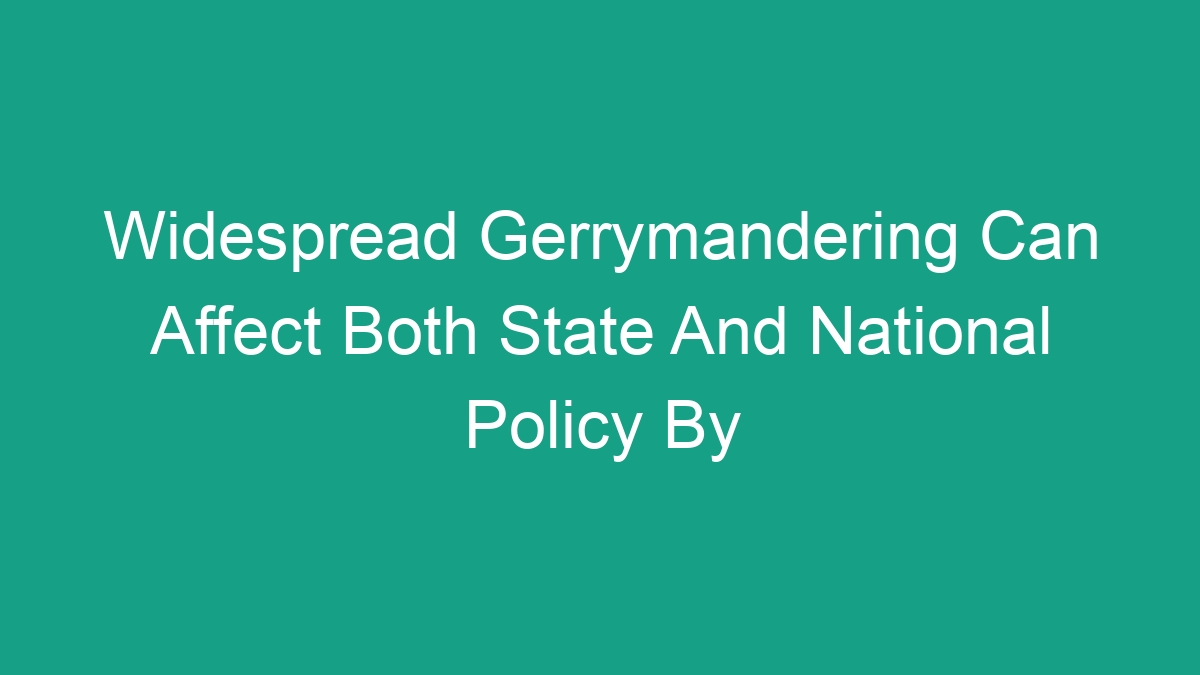
The Impact of Gerrymandering
Gerrymandering is a practice that has been a longstanding issue in American politics. It refers to the deliberate manipulation of electoral district boundaries to favor a particular political party or group. This manipulation can have a significant impact on election outcomes, representation, and ultimately the policies that are enacted at both the state and national levels.
The impact of gerrymandering is widespread and can affect the political landscape in numerous ways. From manipulating voting districts to disenfranchising voters, the consequences of gerrymandering can be far-reaching. In this article, we will explore the ways in which gerrymandering can affect both state and national policy.
Gerrymandering and State Policy
At the state level, gerrymandering can have a direct impact on the composition of state legislatures and the policies that are enacted. By manipulating district boundaries, political parties can secure their control over certain districts, thus influencing the outcomes of state legislative elections.
In states where gerrymandering is rampant, the party in power can draw district lines to ensure that they have a majority of seats in the state legislature, even if they receive fewer overall votes. This can lead to an imbalance in representation, where certain communities are underrepresented and their interests are not adequately addressed in the policymaking process.
The impact of gerrymandering on state policy becomes evident when looking at issues such as healthcare, education, and taxation. By controlling the composition of state legislatures, political parties can push through policies that may not necessarily reflect the will of the people. This can result in disparities in access to healthcare, unequal funding for schools, and regressive tax policies that disproportionately affect certain communities.
Gerrymandering and National Policy
The effects of gerrymandering are not limited to state-level politics. In fact, gerrymandered districts can also have a significant impact on national policy. This is particularly evident in the composition of the U.S. House of Representatives.
Every ten years, the U.S. conducts a national census, which is used to reapportion the seats in the House of Representatives among the states based on population changes. The drawing of district lines following the census is a critical process that can be heavily influenced by gerrymandering.
When political parties in power have the ability to manipulate district boundaries to their advantage, they can effectively control the makeup of the House of Representatives. This can result in a Congress that does not accurately reflect the political preferences of the American people. As a result, the policies enacted by the House of Representatives may not truly represent the will of the electorate.
The impact of gerrymandering on national policy is further exacerbated by the potential for long-term effects. Once district boundaries are redrawn to favor a particular party, it can be challenging to reverse the effects of gerrymandering. As a result, the policies enacted by Congress may not align with the needs and preferences of the American people for years to come.
Efforts to Combat Gerrymandering
In recent years, there has been a growing recognition of the detrimental effects of gerrymandering on the democratic process. As a result, there have been efforts at both the state and national levels to combat gerrymandering and promote fairer electoral practices.
One notable example is the establishment of independent redistricting commissions in certain states. These commissions are tasked with drawing district lines in a nonpartisan manner, with the goal of creating fair and competitive electoral districts. By taking the power of redistricting out of the hands of partisan legislatures, these commissions aim to mitigate the effects of gerrymandering and promote more representative democracy.
Additionally, there have been legal challenges to gerrymandered district maps, with courts playing a crucial role in determining the constitutionality of electoral district boundaries. Some states have also implemented reforms aimed at promoting transparency and public input in the redistricting process, seeking to ensure that district lines are drawn in a manner that reflects the interests of the communities they encompass.
Conclusion
In conclusion, the impact of gerrymandering on both state and national policy cannot be overlooked. The deliberate manipulation of district boundaries to favor a particular political party can have far-reaching consequences, from unequal representation at the state level to distortions in the composition of the House of Representatives. The policies that are enacted as a result of gerrymandering may not accurately reflect the will of the people, and can lead to disparities in access to resources and unequal political influence.
Efforts to combat gerrymandering are crucial in order to promote fair and representative democracy. By implementing measures such as independent redistricting commissions and promoting transparency in the redistricting process, it is possible to mitigate the effects of gerrymandering and ensure that electoral districts are drawn in a manner that accurately reflects the interests and preferences of the electorate. Ultimately, addressing the issue of gerrymandering is essential to upholding the principles of democracy and promoting equitable representation in both state and national policy.



